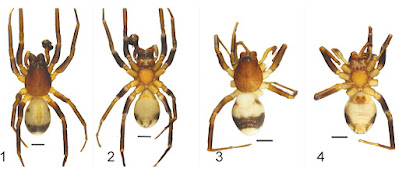 |
| Falconina cafetera Ibarra-Núñez & Marín, 2024 |
Abstract
Falconina cafetera sp. nov. (Araneae, Corinnidae) is described based on specimens of both sexes. Specimens were collected in shaded coffee agro-ecosystems and in a suburban cacao orchard in Chiapas, Mexico. This new species is the first Falconina recorded from Mexico and the northernmost species of the genus in continental America, with the exception of F. gracilis (Keyserling, 1891) introduced to the USA and Cuba. F. cafetera sp. nov. differs from all other Falconina species by having most of its opisthosoma light-colored with some dark patches and by the characteristics of the male palp and female epigynum. Observations are included about one sclerite found in the male palp of this species, not mentioned for other species in this genus. The key of Falconina species by García and Bonaldo (2023) is modified to include this species. Furthermore, field observations and laboratory rearing of juveniles indicate that F. cafetera sp. nov. spiders are able to feed on ants.
Key Words: Coffee agroecosystems, Chiapas, North America, male palpal structure
 |
| Habitus of Falconina cafetera sp. nov. 1, 2. male; 3, 4. female; 1, 3. dorsal view; 2, 4. ventral view. Scale bars: 1 mm (1–4). |
Family Corinnidae Karsch, 1880
Genus Falconina Brignoli, 1985
Falconina cafetera sp. nov.
Differential diagnosis: Males and females differ from all other species by having most of their opisthosoma light in color with some dark patches (Figs 1–4, 21), while in all other species it is mostly dark with some light patches. Males of Falconina cafetera sp. nov. are similar to F. albomaculosa by sharing a long apical spur, by having only two lobes (ventral and median) on the retrolateral tibial apophysis, and by having a lighter, less sclerotized, longitudinal stripe (TPlss) on the sclerotized tegular process (Figs 5–16; figs 13A, 14A in García and Bonaldo 2023). Males of F. cafetera sp. nov. differ from F. albomaculosa by having a prominent prolateral tibial apophysis (small ...
Etymology: The specific name is an arbitrary combination of letters derived from the Spanish word for coffee plantation, “finca cafetalera,” where this species was first collected.
Guillermo Ibarra-Núñez and Linda Marín. 2024. First Record of the Genus Falconina (Araneae, Corinnidae) from Mexico, with A Description of A New Species and Observations on its interactions with Ants. Zoosystematics and Evolution. 100(3): 1099-1106. DOI: doi.org/10.3897/zse.100.127612

